2023 TOYOTA PRIUS PLUG-IN HYBRID low beam
[x] Cancel search: low beamPage 208 of 818
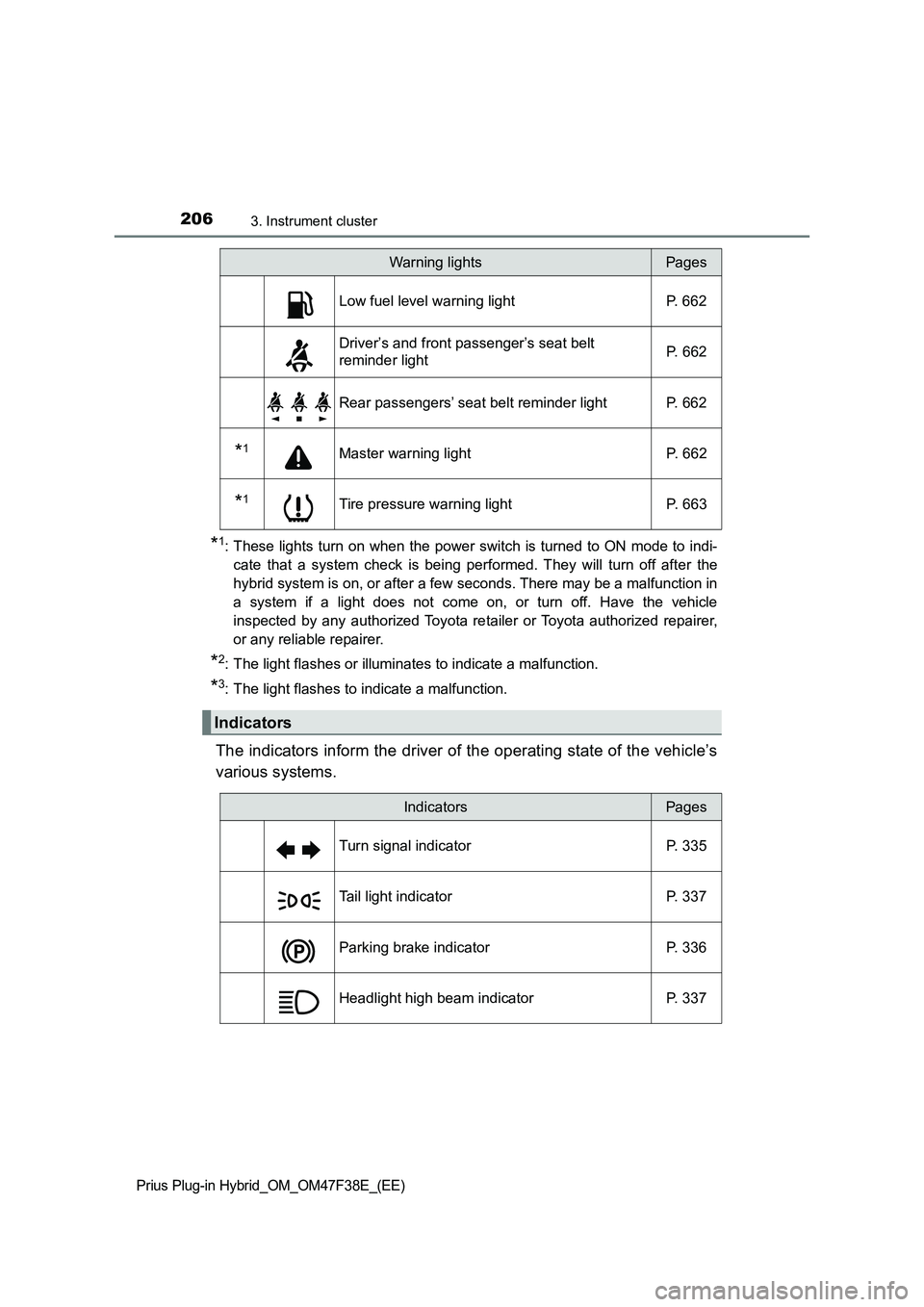
2063. Instrument cluster
Prius Plug-in Hybrid_OM_OM47F38E_(EE)
*1: These lights turn on when the power switch is turned to ON mode to indi-
cate that a system check is being performed. They will turn off after the
hybrid system is on, or after a few seconds. There may be a malfunction in
a system if a light does not come on, or turn off. Have the vehicle
inspected by any authorized Toyota retailer or Toyota authorized repairer,
or any reliable repairer.
*2: The light flashes or illuminates to indicate a malfunction.
*3: The light flashes to indicate a malfunction.
The indicators inform the driver of the operating state of the vehicle’s
various systems.
Low fuel level warning light P. 662
Driver’s and front passenger’s seat belt
reminder lightP. 662
Rear passengers’ seat belt reminder light P. 662
*1Master warning light P. 662
*1Tire pressure warning light P. 663
Indicators
Warning lightsPages
IndicatorsPages
Turn signal indicator P. 335
Tail light indicator P. 337
Parking brake indicator P. 336
Headlight high beam indicator P. 337
Page 339 of 818

3375-3. Operating the lights and wipers
Prius Plug-in Hybrid_OM_OM47F38E_(EE)
5
Driving
Headlight switch
Operating the switch turns on the lights as follows:
The headlights, front
position lights, daytime
running lights ( P. 338)
and so on turn on and
off automatically (when
the power switch is in
ON mode).
The front position, tail,
license plate and instru-
ment panel lights turn
on.
The headlights and all
lights listed above
(except daytime run-
ning lights) turn on.
With the headlights on, push
the lever away from you to turn
on the high beams.
Pull the lever toward you to the
center position to turn the high
beams off.
Pull the lever toward you and
release it to flash the high
beams once.
You can flash the high beams wi th the headlights on or off.
The headlights can be operated manually or automatically.
Operating instructions
1
2
3
Turning on the high beam headlights
IO53PH030
1
2
Page 343 of 818
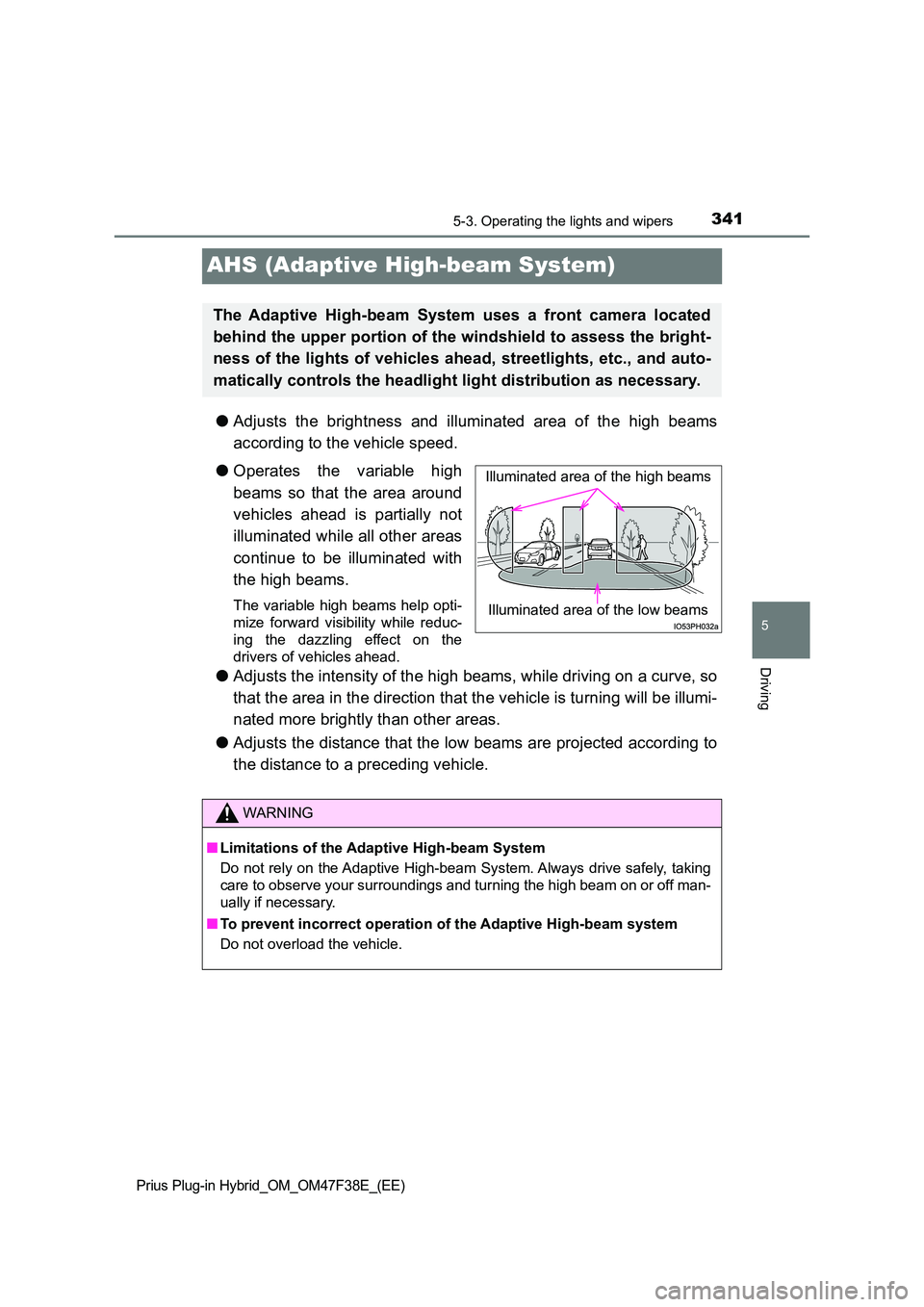
3415-3. Operating the lights and wipers
Prius Plug-in Hybrid_OM_OM47F38E_(EE)
5
Driving
AHS (Adaptive High-beam System)
●Adjusts the brightness and illuminated area of the high beams
according to the vehicle speed.
● Operates the variable high
beams so that the area around
vehicles ahead is partially not
illuminated while all other areas
continue to be illuminated with
the high beams.
The variable high beams help opti-
mize forward visibility while reduc-
ing the dazzling effect on the
drivers of vehicles ahead.
● Adjusts the intensity of the high beams, while driving on a curve, so
that the area in the direction that the vehicle is turning will be illumi-
nated more brightly than other areas.
● Adjusts the distance that the low beams are projected according to
the distance to a preceding vehicle.
The Adaptive High-beam System uses a front camera located
behind the upper portion of the windshield to assess the bright-
ness of the lights of vehicles ahead, streetlights, etc., and auto-
matically controls the headlight light distribution as necessary.
Illuminated area of the high beams
Illuminated area of the low beams
WARNING
■ Limitations of the Adaptive High-beam System
Do not rely on the Adaptive High-beam System. Always drive safely, taking
care to observe your surroundings and turning the high beam on or off man-
ually if necessary.
■ To prevent incorrect operation of the Adaptive High-beam system
Do not overload the vehicle.
Page 345 of 818
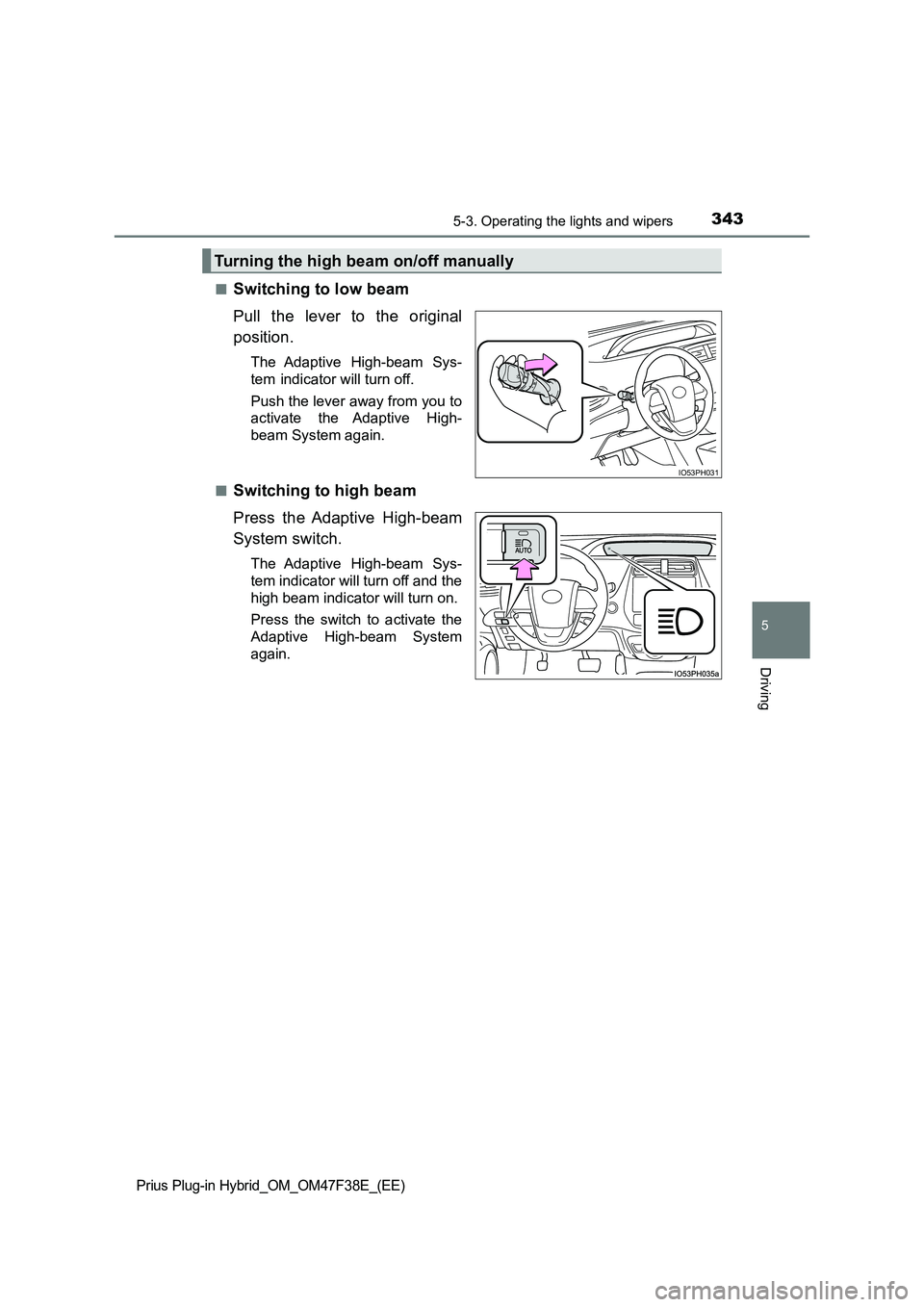
3435-3. Operating the lights and wipers
Prius Plug-in Hybrid_OM_OM47F38E_(EE)
5
Driving
■Switching to low beam
Pull the lever to the original
position.
The Adaptive High-beam Sys-
tem indicator will turn off.
Push the lever away from you to
activate the Adaptive High-
beam System again.
■Switching to high beam
Press the Adaptive High-beam
System switch.
The Adaptive High-beam Sys-
tem indicator will turn off and the
high beam indicator will turn on.
Press the switch to activate the
Adaptive High-beam System
again.
Turning the high beam on/off manually
IO53PH031
Page 346 of 818
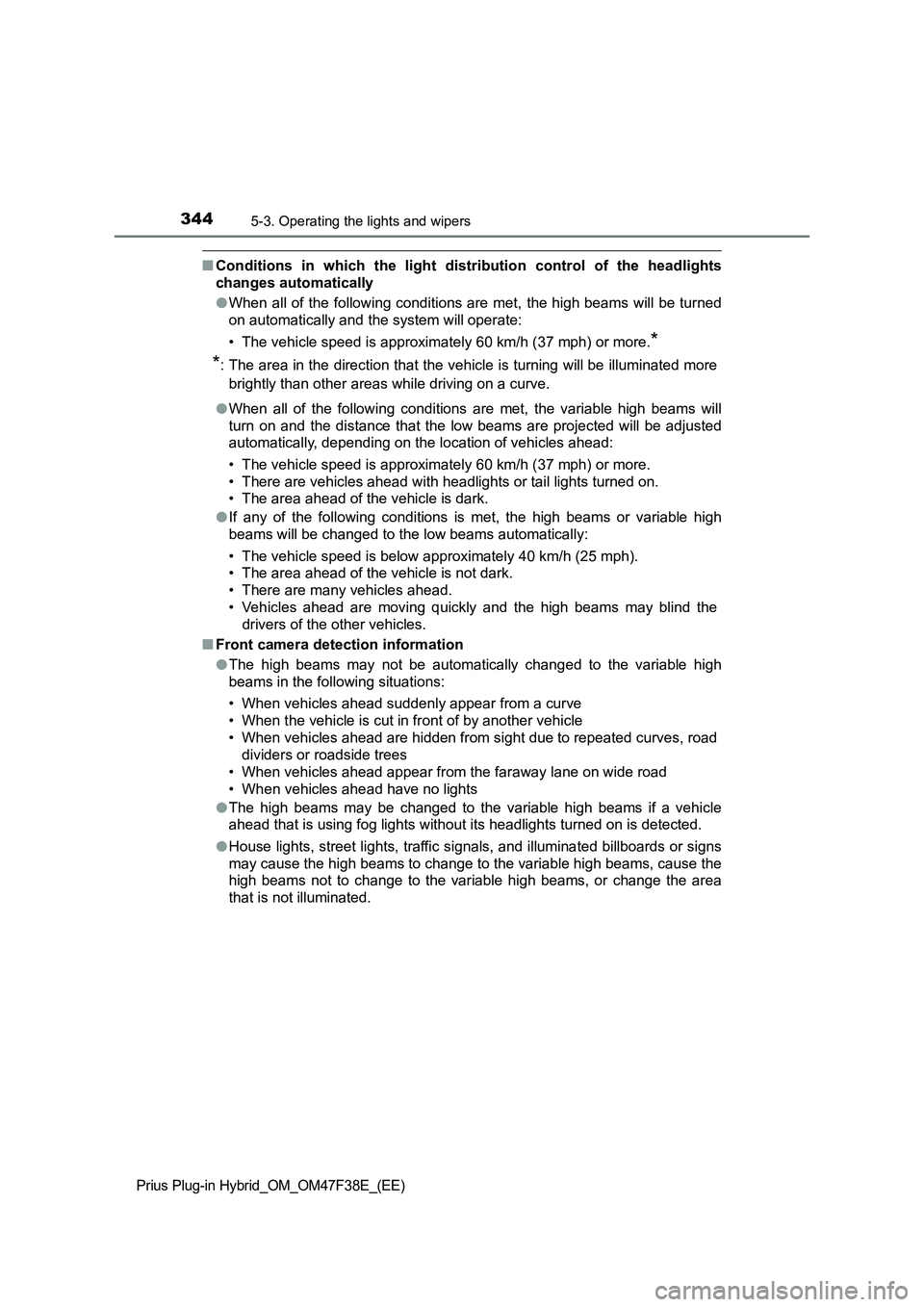
3445-3. Operating the lights and wipers
Prius Plug-in Hybrid_OM_OM47F38E_(EE)
■Conditions in which the light distribution control of the headlights
changes automatically
●When all of the following conditions are met, the high beams will be turned
on automatically and the system will operate:
• The vehicle speed is approximately 60 km/h (37 mph) or more.
*
*
: The area in the direction that the vehicle is turning will be illuminated more
brightly than other areas while driving on a curve.
●When all of the following conditions are met, the variable high beams will
turn on and the distance that the low beams are projected will be adjusted
automatically, depending on the location of vehicles ahead:
• The vehicle speed is approximately 60 km/h (37 mph) or more.
• There are vehicles ahead with headlights or tail lights turned on.
• The area ahead of the vehicle is dark.
●If any of the following conditions is met, the high beams or variable high
beams will be changed to the low beams automatically:
• The vehicle speed is below approximately 40 km/h (25 mph).
• The area ahead of the vehicle is not dark.
• There are many vehicles ahead.
• Vehicles ahead are moving quickly and the high beams may blind the
drivers of the other vehicles.
■Front camera detection information
●The high beams may not be automatically changed to the variable high
beams in the following situations:
• When vehicles ahead suddenly appear from a curve
• When the vehicle is cut in front of by another vehicle
• When vehicles ahead are hidden from sight due to repeated curves, road
dividers or roadside trees
• When vehicles ahead appear from the faraway lane on wide road
• When vehicles ahead have no lights
●The high beams may be changed to the variable high beams if a vehicle
ahead that is using fog lights without its headlights turned on is detected.
●House lights, street lights, traffic signals, and illuminated billboards or signs
may cause the high beams to change to the variable high beams, cause the
high beams not to change to the variable high beams, or change the area
that is not illuminated.
Page 347 of 818
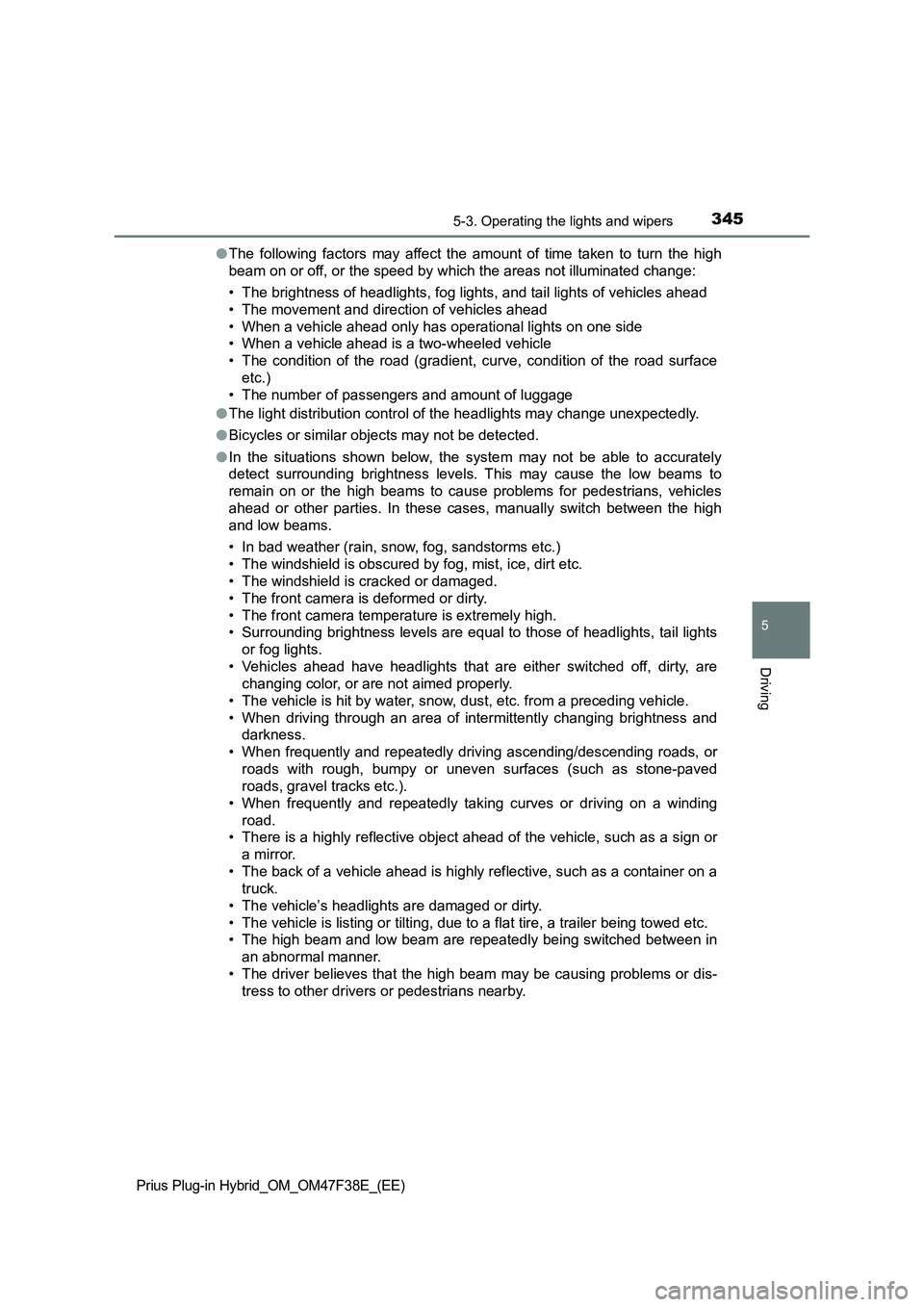
3455-3. Operating the lights and wipers
Prius Plug-in Hybrid_OM_OM47F38E_(EE)
5
Driving
●The following factors may affect the amount of time taken to turn the high
beam on or off, or the speed by which the areas not illuminated change:
• The brightness of headlights, fog lights, and tail lights of vehicles ahead
• The movement and direction of vehicles ahead
• When a vehicle ahead only has operational lights on one side
• When a vehicle ahead is a two-wheeled vehicle
• The condition of the road (gradient, curve, condition of the road surface
etc.)
• The number of passengers and amount of luggage
●The light distribution control of the headlights may change unexpectedly.
●Bicycles or similar objects may not be detected.
●In the situations shown below, the system may not be able to accurately
detect surrounding brightness levels. This may cause the low beams to
remain on or the high beams to cause problems for pedestrians, vehicles
ahead or other parties. In these cases, manually switch between the high
and low beams.
• In bad weather (rain, snow, fog, sandstorms etc.)
• The windshield is obscured by fog, mist, ice, dirt etc.
• The windshield is cracked or damaged.
• The front camera is deformed or dirty.
• The front camera temperature is extremely high.
• Surrounding brightness levels are equal to those of headlights, tail lights
or fog lights.
• Vehicles ahead have headlights that are either switched off, dirty, are
changing color, or are not aimed properly.
• The vehicle is hit by water, snow, dust, etc. from a preceding vehicle.
• When driving through an area of intermittently changing brightness and
darkness.
• When frequently and repeatedly driving ascending/descending roads, or
roads with rough, bumpy or uneven surfaces (such as stone-paved
roads, gravel tracks etc.).
• When frequently and repeatedly taking curves or driving on a winding
road.
• There is a highly reflective object ahead of the vehicle, such as a sign or
a mirror.
• The back of a vehicle ahead is highly reflective, such as a container on a
truck.
• The vehicle’s headlights are damaged or dirty.
• The vehicle is listing or tilting, due to a flat tire, a trailer being towed etc.
• The high beam and low beam are repeatedly being switched between in
an abnormal manner.
• The driver believes that the high beam may be causing problems or dis-
tress to other drivers or pedestrians nearby.
Page 357 of 818
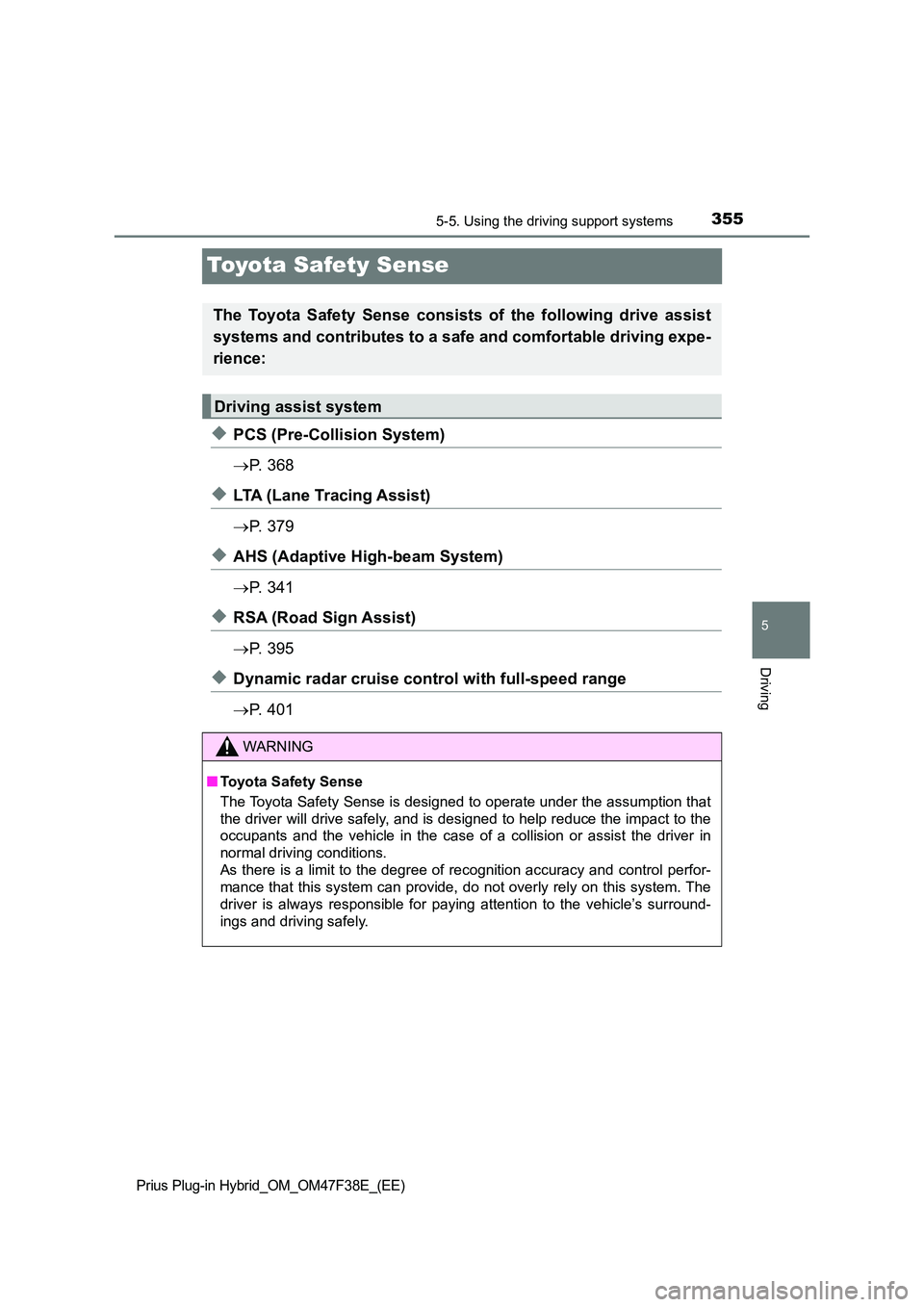
3555-5. Using the driving support systems
Prius Plug-in Hybrid_OM_OM47F38E_(EE)
5
Driving
Toyota Safety Sense
◆PCS (Pre-Collision System)
P. 3 6 8
◆LTA (Lane Tracing Assist)
P. 3 7 9
◆AHS (Adaptive High-beam System)
P. 3 4 1
◆RSA (Road Sign Assist)
P. 3 9 5
◆Dynamic radar cruise control with full-speed range
P. 4 0 1
The Toyota Safety Sense consists of the following drive assist
systems and contributes to a safe and comfortable driving expe-
rience:
Driving assist system
WARNING
■ Toyota Safety Sense
The Toyota Safety Sense is designed to operate under the assumption that
the driver will drive safely, and is designed to help reduce the impact to the
occupants and the vehicle in the case of a collision or assist the driver in
normal driving conditions.
As there is a limit to the degree of recognition accuracy and control perfor-
mance that this system can provide, do not overly rely on this system. The
driver is always responsible for paying attention to the vehicle’s surround-
ings and driving safely.
Page 461 of 818

4595-5. Using the driving support systems
Prius Plug-in Hybrid_OM_OM47F38E_(EE)
5
Driving
■Situations in which the system may operate even if there is no possibil-
ity of a collision
In some situations, such as the following, the system may operate even
though there is no possibility of a collision.
● When driving toward a banner, flag, low-hanging branch or boom barrier
(such as those used at railroad crossings, toll gates and parking lots)
● When there is a rut or hole in the surface of the road
● When driving on a metal cover (grating), such as those used for drainage
ditches
● When driving up or down a steep slope
● If a sensor is hit by a large amount of water, such as when driving on a
flooded road
● There is dirt, snow, water drops or ice on a sensor. (Cleaning the sensors
will resolve this problem.)
● A sensor is coated with a sheet of spray or heavy rain
● When driving in inclement weather such as fog, snow or a sandstorm
● When vehicle horns, vehicle detectors, motorcycle engines, air brakes of
large vehicles, the clearance sonar of ot her vehicles or other devices which
produce ultrasonic waves are near the vehicle
● If the front of the vehicle is raised or lowered due to the carried load
● If the orientation of a sensor has been changed due to a collision or other
impact
● Driving close to columns (H-shaped steel beams, etc.) in multi-story parking
garages, construction sites, etc.
● If the vehicle cannot be driven in a stable manner, such as when the vehicle
has been in an accident or is malfunctioning
● When driving on a narrow road
● When strong winds are blowing